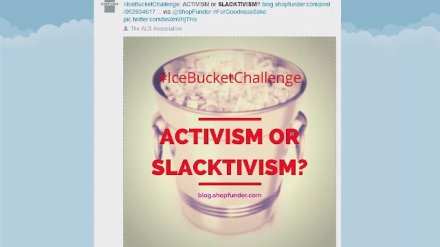The ALS challenge was one of the largest social media phenomenon’s that took place primarily on Facebook. During the summer of 2014 Facebook’s newsfeeds were filled with videos of people pouring buckets of ice and water on themselves, it was described as “the largest chain letter ever”. Once the movement became viral there were countless celebrities  joining in on the movement even President Obama joined in. The social media movement for ALS brought in over 100 million dollars to the ALS Association, which is a great improvement compared to 2013 which was 23.5 million. Therefore it is easy to look at this social media “movement” as a success.
joining in on the movement even President Obama joined in. The social media movement for ALS brought in over 100 million dollars to the ALS Association, which is a great improvement compared to 2013 which was 23.5 million. Therefore it is easy to look at this social media “movement” as a success.

Although Facebook and other social medias had helped to raise a great deal of money to the ALS association, there was a lot of backlash when looking at how it was done. As described in the “Times” article, they argue that the ice bucket challenge was not seen as a proper way of activism. By essentially awarding the individual who dumped ice water on themselves, meant that they were not contributing to the ALS association. Also the article discussed how once the ice bucket challenge was no longer seen as a trending topic online the donations had a significant decrease. Also when people were doing the ice bucket challenge many of the participants did not even mention that it was linked to ALS, but rather doing it for thesocial media aspect. The ice bucket challenge can be viewed as a social media movement that helped to raise a great deal of money for an association, however since social media is such a fast paced network, users are always looking for the next fad to get hooked on. Therefore once the ice bucket challenge was no longer popular users no longer cared about the ALS ice bucket challenge.
ice bucket challenge was not seen as a proper way of activism. By essentially awarding the individual who dumped ice water on themselves, meant that they were not contributing to the ALS association. Also the article discussed how once the ice bucket challenge was no longer seen as a trending topic online the donations had a significant decrease. Also when people were doing the ice bucket challenge many of the participants did not even mention that it was linked to ALS, but rather doing it for thesocial media aspect. The ice bucket challenge can be viewed as a social media movement that helped to raise a great deal of money for an association, however since social media is such a fast paced network, users are always looking for the next fad to get hooked on. Therefore once the ice bucket challenge was no longer popular users no longer cared about the ALS ice bucket challenge.

“Articles like this one, reductively titled “Stop hating on the ice bucket challenge — it’s raised millions of dollars for charity,” miss the point. In an age where hashtag activism and information-free awareness campaigns are becoming more and more common, we should be very conscious of how to make viral trends as useful as possible.”(TImes)
After analyzing the impacts of the ice bucket challenge on social media specifically Facebook, it makes me question social media being seen as an effective tool. Yes, social media helped to raise over 100 million dollars, but clearly the message of the ice bucket challenge got lost along the way. Most people did not even talk about ALS in their ice bucket videos. Social media is seen to be a very democratic space, where people can freely express their opinions and help to spread awareness. Social media allows for users to have their own “media house” meaning they have the ability to post and express their individual opinion and share it will thousands of other users. However, with Facebook there is a great deal of corporate control through the use of advertisements and unnecessary messages. In an ideal utopian online space there would be no corporate control dictating what is being posted to users newsfeeds.

I also think that with the ALS challenge there should have been a more IRL connection seeing that majority of the challenge was not based around face-to-face communication. I believe that IRL connection is much stronger than the URL connection. If the ice bucket challenge helped to gather some of the users online their decline in donations would not have happened as drastically as it did. I think that social media can be seen as a useful tool when paired with a strong IRL bond. If the ice bucket challenge started as a face-to-face association it would have created a lasting impact on the people versus posting a video to Facebook. Therefore in a utopian world social media would not be seen as our first outlet to turn to but rather meeting with people in an IRL situation.

Caitlin F.